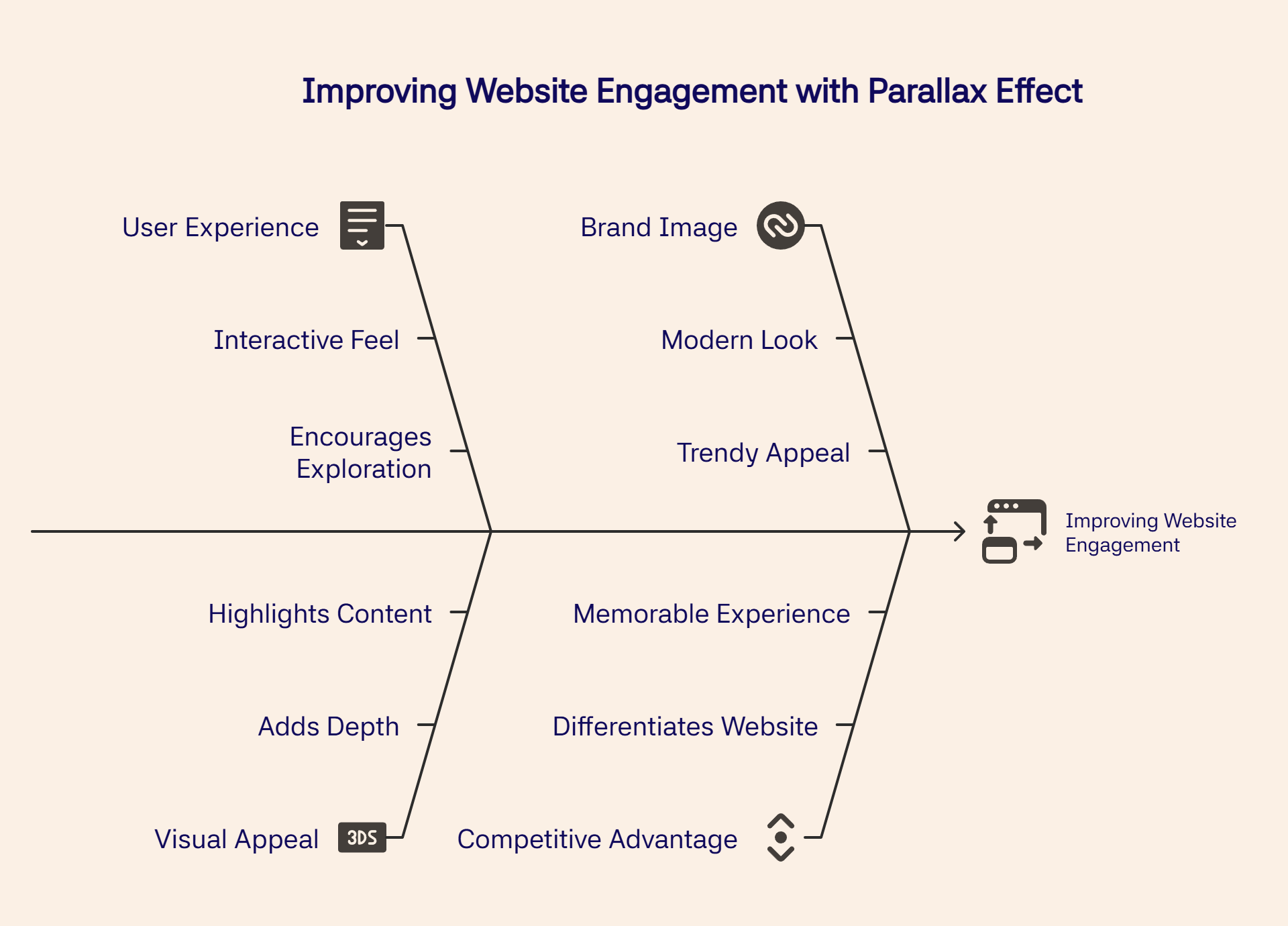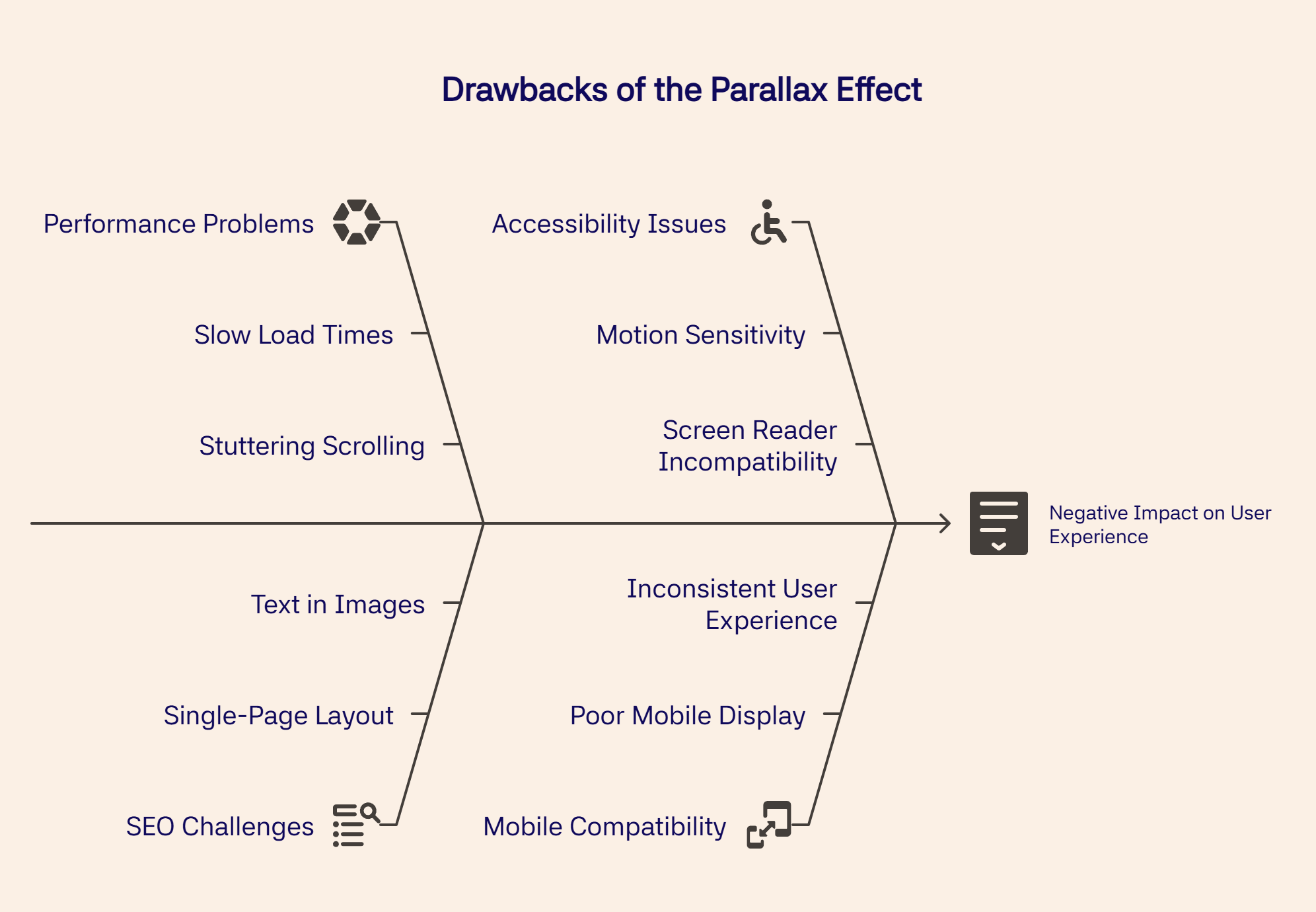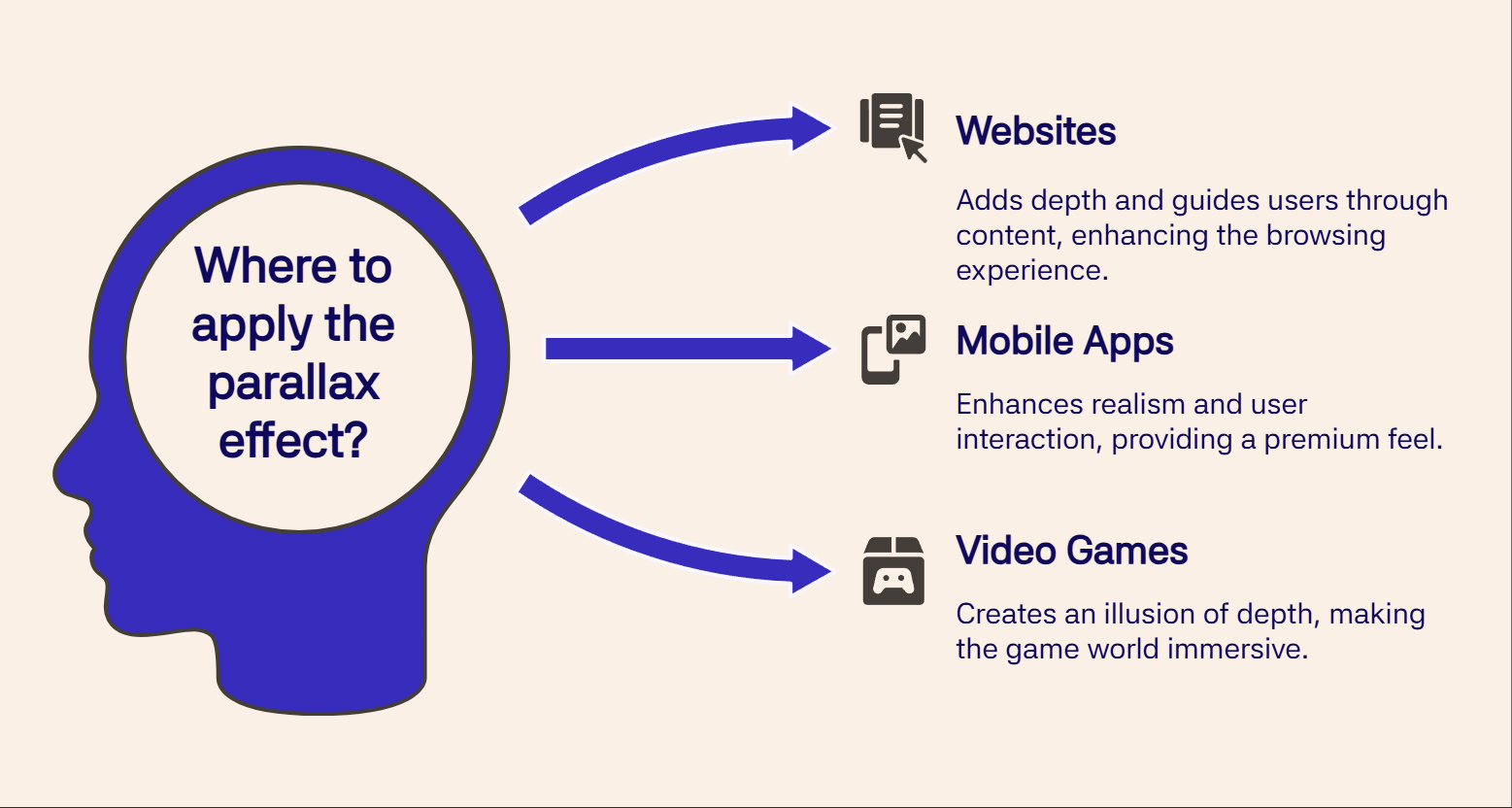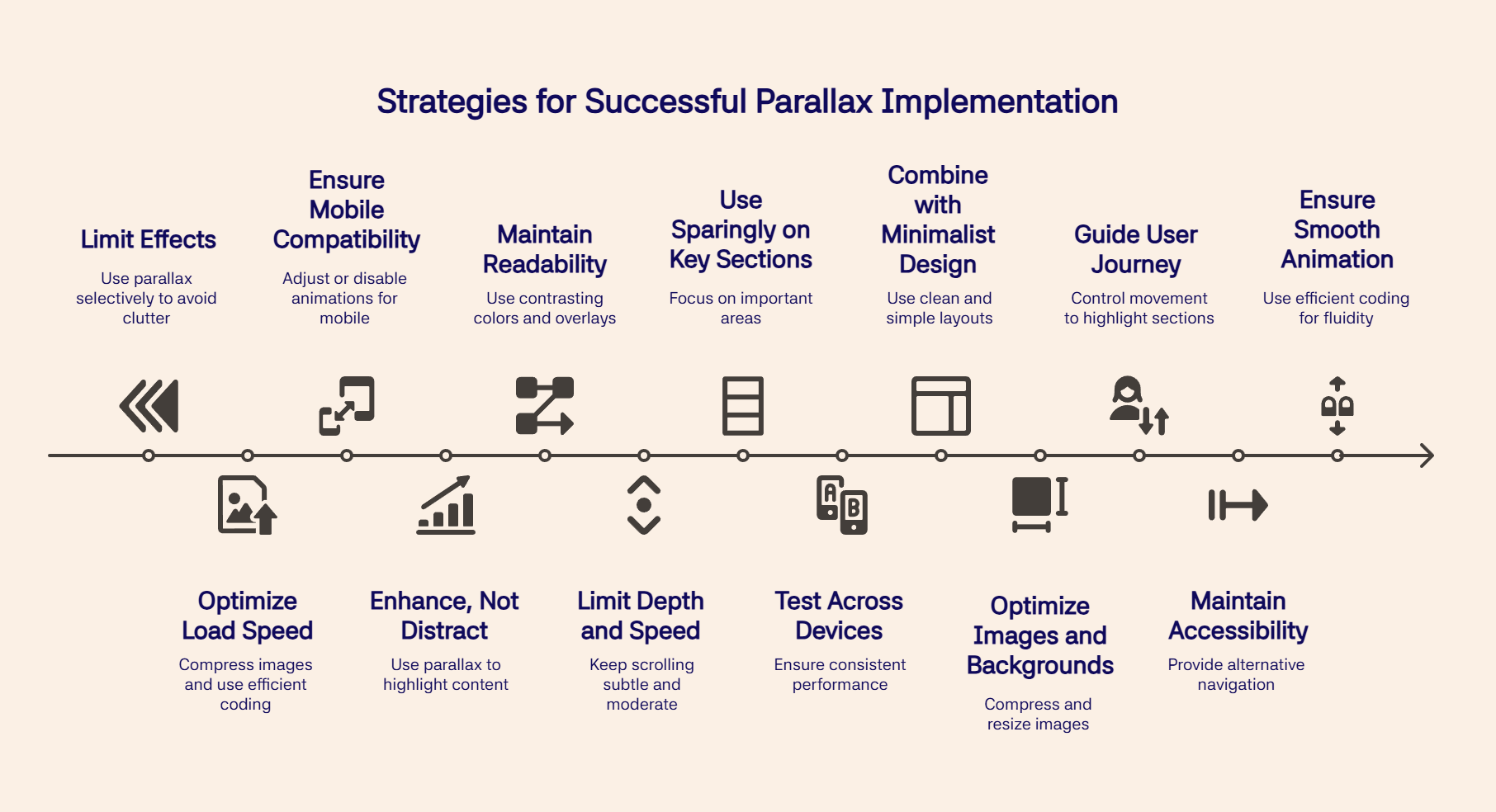The parallax effect is a web design technique where background elements move more slowly than foreground elements during scrolling. This creates a sense of depth and motion, making websites feel more dynamic and visually engaging. It is commonly used to highlight key content and improve user interaction.
The parallax effect adds depth, motion, and style that instantly grabs attention. In this guide, you’ll learn what it is, where to use it, and whether it’s the right fit for your site.
TL;DR:
-
Parallax effect creates visual depth by moving background elements slower than foreground during scrolling, boosting user engagement and retention
-
Offers 8 key benefits including drawing attention to important sections, improving time on page, and building a modern brand image
-
Has 5 major drawbacks: slower load times, SEO challenges, accessibility issues, navigation problems, and poor mobile compatibility
-
Successfully implement by limiting effects, optimizing load speed, ensuring mobile-friendliness, and maintaining readability over moving backgrounds
What Is Parallax Effect?
The parallax effect is a scrolling technique where background elements move more slowly than foreground elements, creating an illusion of depth. This effect makes websites feel more interactive and visually engaging. Designers often use it to highlight content, improve storytelling, and enhance user experience.
This effect is often used to guide the visitor through content step by step, highlighting products or services and giving the website a stylish and professional feel.
It’s popular on landing pages, portfolios, and brand websites because it helps catch attention quickly and keeps visitors interested.
What Are The Major Benefits Of The Parallax Effect?
The parallax effect benefits websites by drawing attention to key sections, improving user retention, and adding visual depth. It encourages exploration, highlights content creatively, and builds a modern brand image.
Parallax also enhances interactivity and helps differentiate your site from competitors with a more dynamic experience.

Parallax effect is one of the most trendy web designs recently, and it comes with 8 major benefits.
Draws Attention to Key Sections
The parallax effect naturally guides the visitor’s eyes. When something moves differently from the rest of the page, people notice it more. This makes it easier to highlight important sections, like a product, service, or call-to-action button.
Improves User Retention and Time on Page
Websites with parallax feel more interactive and less boring. Visitors enjoy scrolling through the movement and animations, so they usually spend more time on the site instead of leaving quickly.
Adds Depth and Dimension to Design
Parallax creates a layered, 3D-like effect that makes the design look richer and more engaging. It breaks the flat look of a normal page and makes the website feel more alive.
Differentiates Your Website From Competitors
Many websites look similar, but parallax can make yours stand out. A unique scrolling experience gives visitors something memorable, which helps your brand look more modern and creative.
Encourages Scrolling and Exploration
Parallax makes scrolling feel exciting instead of boring. Visitors are curious to see what happens next as the page moves, so they keep exploring more sections of your site. This increases the chances they’ll see more of your content.
Supports a More Interactive Feel
Instead of a plain, static page, parallax gives a sense of motion and interaction. It makes visitors feel like they are part of the experience rather than just reading information. This creates a stronger connection between your site and the user.
Highlights Product or Service Features Creatively
Parallax can be used to showcase products or services in a more dramatic way. For example, images, text, or animations can appear as the visitor scrolls, which makes the features stand out. This creative presentation can leave a lasting impression.
Builds a Modern and Trendy Brand Image
Using parallax shows that your brand is up-to-date with design trends. It gives your website a stylish, cutting-edge look that helps you appear more professional and innovative. This helps build trust and appeal with your audience.
After knowing all the benefits of parallax, you must be thinking this is the ultimate guide to website design for you. However, it also has five considerable drawbacks.
What Are The Drawbacks of The Parallax Effect?
The parallax effect has drawbacks including slower load times, SEO challenges, accessibility issues, navigation difficulties, and poor mobile compatibility.
These issues can affect user experience, reduce search visibility, and cause visitors to leave if the site is not optimized across devices and user needs.

Performance Problems
The parallax effect relies on large background images, layers, and scripts that move at different speeds. While this looks great visually, it can put a lot of pressure on the browser and the device.
On older computers or slower internet connections, pages may take longer to load or may stutter while scrolling. A slow-loading website can frustrate visitors, and research shows that many users leave a site if it takes more than a few seconds to load.
SEO Challenges
One of the most important goals of a website owner is to make the website visible in search engines. Search engines like Google work best when content is spread out across multiple pages with clear headings, links, and keywords.
Many parallax websites use a single long scrolling page, which may combine all content into one URL. This reduces the chances of ranking for different keywords and makes it harder for search engines to understand the structure of the site.
Also, if text is embedded inside images or animations instead of being written in code, Google may not read it at all. This could hurt the website’s visibility in search results.
Accessibility Issues
Not every visitor interacts with websites in the same way. For people who have motion sensitivity, the moving backgrounds and animations can cause discomfort, dizziness, or nausea.
On top of that, screen readers, used by people with visual impairments, may not be able to interpret parallax layouts properly. If the site isn’t designed with accessibility in mind, a whole group of visitors may struggle to use it.
Navigational Problems
A parallax website often works as one big page instead of many smaller ones. While this can create a smooth storytelling experience, it may frustrate visitors who want to quickly find a specific piece of information.
Without proper menus, links, or anchor points, users may have to scroll through a lot of content before reaching what they need.
In some cases, scrolling animations can even make navigation feel slow or confusing. If visitors cannot find the information they need easily, they may leave the site and look elsewhere.
Mobile Compatibility
Many parallax effects are designed with desktop screens in mind, where there’s plenty of space and processing power. On mobile devices, however, the same animations may not display correctly or may slow down the phone.
Since most users now browse the web on their phones, this is a major drawback. Some designers disable parallax on mobile devices to avoid these problems, but this means mobile visitors don’t get the same experience as desktop users.
If not handled carefully, this can affect both user satisfaction and brand consistency.
Where Can You Apply Parallax?
You can apply the parallax effect in websites, mobile apps, and video games.
-
On websites, it adds depth and guides users through content.
-
In mobile apps, it enhances realism and user interaction.
-
In video games, it creates an illusion of depth by moving background layers at different speeds.

Websites
Parallax is widely used in modern web design to grab attention and make pages feel alive. When visitors scroll, the background and foreground move at different speeds, which creates depth and makes the journey through the site more enjoyable.
Businesses often use it on homepages, product showcases, portfolios, and storytelling sections to guide users step by step and highlight important content in a creative way.
Mobile Apps
In mobile apps, parallax adds smooth motion and a sense of realism. For example, when you tilt or scroll, certain images or backgrounds shift slightly, which creates a layered effect.
This makes the app feel more engaging and intuitive to use. Designers often apply it in app menus, galleries, or feature highlights to give a premium and modern experience without cluttering the interface.
Video Games
Parallax has been a classic technique in video games for decades. In 2D games, different background layers (like skies, mountains, or forests) move at different speeds compared to the main character or objects in the foreground.
This trick gives players the illusion of depth and makes the game world feel more immersive. Even in modern games, parallax is used to enhance realism and storytelling.
What Are The Proven Strategies For Successfully Using Parallax In a Website?
Successfully use parallax by limiting effects, optimizing load speed, and ensuring mobile compatibility. Prioritize readability, test across devices, and guide users with subtle motion. Keep animations smooth, apply effects sparingly, and follow accessibility standards to enhance user experience without sacrificing performance or usability.

Before you attempt to implement parallax in your website, you need to follow these 13 basic strategies.
Don’t Overwhelm With Too Many Effects
Parallax works best when it’s used selectively. Adding too many moving elements on a single page can confuse visitors and make the website feel cluttered. Keep animations simple and purposeful so users can focus on your key content without getting distracted.
Ensure Fast Page Load Times
Parallax often uses large images and scripts, which can slow down your website. According to a study by Hostinger, 39% of users lose interest when images load slowly.
To avoid this, compress images, use efficient coding, and minimize unnecessary animations. A fast-loading site keeps visitors happy and reduces the chance they’ll leave before seeing your content.
Make It Mobile-Friendly
Not all parallax effects work well on small screens or slower mobile devices. Make sure your website adjusts properly for mobile, either by simplifying or disabling certain animations. This ensures mobile users get a smooth experience without glitches or lag.
Use Parallax to Enhance, Not Distract
The main goal of parallax is to make your website more engaging, not to take attention away from your content. Use it to highlight important sections, tell a story, or showcase products creatively. Always prioritize clarity and usability over fancy effects.
Keep Text Readable Over Moving Backgrounds
Parallax often involves moving images or layers behind text. If the background is too busy or moves too fast, it can make text hard to read. Use contrasting colors, semi-transparent overlays, or simpler backgrounds to ensure your messages remain clear and easy to read.
Limit the Depth and Speed of Scrolling Layers
Too much movement or extreme differences in speed between layers can be distracting or even dizzying for visitors. Keep the depth subtle and the scrolling speed moderate to create a smooth, pleasant experience without overwhelming users.
Use Parallax Sparingly on Key Sections
Parallax is most effective when used to highlight important sections, such as product showcases, storytelling segments, or call-to-action areas. Using it everywhere can make the website feel cluttered and reduce its impact. Focus on key spots where it adds value.
Test Across Multiple Browsers and Devices
Different browsers and devices may display parallax effects differently. Always test your website on desktops, laptops, tablets, and phones to ensure smooth performance and consistent appearance.
This helps provide a good experience for all visitors, regardless of how they access your site.
Combine With a Minimalist Design for the Best Impact
Parallax works best when the overall design is clean and simple. Minimalist layouts allow the scrolling effects to stand out without making the page feel cluttered. This makes your website look modern and helps visitors focus on your key content.
Optimize All Images and Backgrounds
Large images can slow down your website, especially with parallax. Compress and resize images properly so they load quickly without losing quality. Optimized backgrounds ensure smooth scrolling and better performance for all users.
Use Parallax to Guide the User Journey
Parallax can help lead visitors through your website in a planned way. By controlling the flow of movement, you can highlight important sections or calls-to-action, making it easier for users to follow the story or take desired actions.
Maintain Accessibility Standards
Even with advanced effects, your website should remain accessible. Provide alternative ways to navigate, avoid overly fast or disorienting animations, and make sure text is readable for all users. This ensures everyone can enjoy your site, including people with disabilities.
Ensure Smooth and Jitter-Free Animation
Choppy or jittery animations can ruin the user experience. Test your parallax effects carefully and use efficient coding and optimization techniques to keep the scrolling smooth. A fluid experience keeps visitors engaged and makes your site feel professional.
Also, make sure your website is well-built. To achieve a well-built website, you don’t always have to know coding. You can try the Dorik AI website builder, which makes a website for you without having to apply any code.
FAQs
What are the two types of parallax?
The two types of parallax are horizontal and vertical. Horizontal parallax moves layers side-to-side, while vertical parallax moves layers up and down. Both create depth and make websites or games appear more dynamic and engaging.
Why is parallax scrolling avoided?
Parallax scrolling is sometimes avoided because it can slow down website performance, cause navigation or readability issues, create accessibility challenges, and may not display properly on mobile devices. Overuse can distract users from the main content.
What does parallax mean in video games?
In video games, parallax refers to a technique where background layers move more slowly than foreground objects, which creates an illusion of depth. It makes 2D game worlds feel more realistic and immersive, which enhances the player’s visual experience and gameplay.
Conclusion
That’s all about the parallax effect. I hope this article helps you with everything you need to know about this. Now you can implement this effect with proper knowledge.
Remember, your first priority should be user friendliness. So, don’t overdo anything. Always keep your website polished and upgraded.
Now it's time to say goodbye. Have a good day!





